This song reflects upon the themes conjured up by The Kinks 'Waterloo Sunset'.
Were the swinging 60s a myth.
Has anything really changed.
Did we still hanker after Empire - or are we Europeans now.
Or are we still unsure ?
9 November 2009
One World
A video in support of iPeace.
Please share this video.
www.ipeace.me
Please share this video.
www.ipeace.me
Labels:
Bedrock,
Endless Records,
iPeace,
One World,
Steve Kelly,
Tipping Point,
Wales
Golden Handshake Shuffle
An, unapologetic, sarcastic exposition of deregulated, free market, 'laissez faire' economics.
Or to put it another way - it's a bit political - and it contains one expletive in the text - so please be warned.
Or to put it another way - it's a bit political - and it contains one expletive in the text - so please be warned.
6 October 2009
Obituary: Michael English
Michael English
Graphic artist and rock band member whose posters encapsulated the swinging 60s.
Written by:
Michael McNay
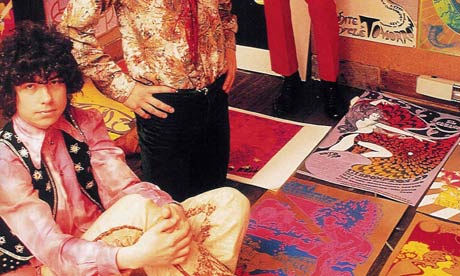
Michael English in the late 1960s
The 1960s was when ephemera became non-ephemeral. Starting from small boutiques in Chelsea, Mary Quant and Barbara Hulanicki conquered the known world and Jean Shrimpton was crowned queen; Alan Aldridge proved that covers sold Penguins; each successive Beatles album sleeve became as collectable as the vinyl within; David Bailey inspired Michelangelo Antonioni to mythologise the scene in his movie Blow-Up; and Time magazine pronounced the benediction. With the passing of the 60s, none of this curled up into yellowing heaps of fading memory. Instead, it has gained a quasi-immortality in the salerooms and on eBay – among it the early work of the artist Michael English, who has died aged 68, after five years of suffering from bone marrow cancer.
English's epiphany was the moment in King's Road, Chelsea, in December 1966 when he chanced upon the graphic artist Nigel Waymouth painting the facade of Granny Takes a Trip, London's first psychedelic boutique. Together they created a graphics team doubling up as a rock group called Hapshash and the Coloured Coat. This kind of music and this kind of pop art seemed natural bedfellows; both emerged from the art schools to which, before educationists pasted on an academic veneer, kids had no need of any passport but talent.
English studied at Ealing art school in west London, where Roy Ascott had introduced an innovative method of inducing creativity called the ground course. Ascott had studied at Newcastle upon Tyne under Richard Hamilton. And so it goes. Hamilton was the intellectual face of pop art, operating at a cool remove from the actual pop scene, commenting on it without being directly involved. Ascott was a facilitator, and English became the most prolific producer of pop art at the interface with the real admass – a potent mix of art nouveau with hard-edge sci-fi applied to disposable items such as union flag sunglasses, T-shirts, carrier bags, and graphics for the underground paper International Times.
Most of all there were the posters, for the UFO (Unlimited Freak Out) club in Tottenham Court Road, for Pink Floyd and Jimi Hendrix, in favour of saving the Earth (already), a glorious sunburst for a Hapshash album sleeve and, prescient of work to come, a sensual, vermilion painted mouth with gleaming white teeth spilling out tendrils blossoming into fat letters like lush tropical fruit spelling out "Love festival". However amorphous the 60s prescription for love to save the world, in his own life those close to English testified to his kindness, warmth and loving nature.
The unlikely source for the general burst of graphic creativity was the Victoria and Albert museum, that vast mausoleum of the art and artefacts of empire which nudged the zeitgeist with exhibitions of Aubrey Beardsley and the Czech genius of art nouveau, Alfons Mucha. The images emerging from the languid and insolent decadence of their spiralling line held immense appeal for the 60s generation, and Hapshash and the Coloured Coat made the most of it.
English was born in Bicester, Oxfordshire, and, like a lot of children in service families, was constantly on the move. His early education was at a series of boarding schools. After the second world war his father, Nigel English, left the RAF and worked for the electrical engineering firm Ferranti. Some of this may have rubbed off on his son, because when Michael tired of the 60s scene after the total flop of a Hapshash musical gig in Amsterdam in 1968 ("We lost the plot," Waymouth later confessed), he worked his way through to an unabashed style of hyper-real art celebrating the triumph of commerce.
The engorged lips of the love festival poster mutated now into lips blowing an improbably beautiful transparent globe of bubblegum or viscously spilling syrup. The fascination with surfaces produced possibly the best known of his pieces, the Coke bottle cap of 1970, bent after being removed by a bottle opener and splashed with liquid. The same year saw a crushed can of tomato juice spilling its thick red liquid, and an SR toothpaste tube with the paste oozing forth in a serpentine ribbon recalling the art-nouveau wrigglings of his first works.
He moved on to industrial hardware, objectified like sexual fetishes: a wheel and pistons of a railway engine, an aircraft jet fan, a truck's diesel filling cap, a smashed bottle lying on a bed of moss. And in all these, the paint surfaces, the hints of rust, the dangerous edge of broken glass appear with a heightened fidelity that made him the must-hit target for advertising agencies.
And so English loaned his talents to marketing the products of such diverse companies as Bertolli, Swiss Air, BA and Porsche. All along he yearned to go straight, to paint like a "real" artist. He went to the Seychelles for subject matter and came back, of course, with hyper-real natural imagery. He painted it proficiently but his real talent lay in romanticising the chill seductiveness of the machine age, a talent reprised with designs for special postage stamp issues in 2001 (old London buses) and 2004 (vintage motorbikes).
His wife, Jaki, survives him, and is organising a show of his work.
Michael English, artist, born September 5 1941; died September 25 2009
guardian.co.uk © Guardian News and Media Limited 2009
The State Of Our Nation today
In the wake of the Labour Party conference last week, and as the Conservative Party’s conference takes place, it is clear that the campaign for the next general election is under way.
No sane person would contend that our budget deficit is not in need of some serious attention.
At present the choice would seem to be between the Conservatives contention that a serious reduction is essential now and Labour’s argument that phased reductions over the lifetime of the next parliament would be more appropriate.
What I look for, when it comes to issues of this magnitude, is not just the proposed policies on offer, what concerns me more is the analysis that underpins and informs the policies.
In other words if someone doesn’t understand how and why the present situation evolved then it follows, in my opinion, that they are less likely to be able to deliver the most apposite solution.
From the presentation of the issues by our media one could be forgiven for concluding that Gordon Brown is single-handedly responsible for the current global financial crisis.
Really ?
Or that he is single-handedly responsible for the budget deficit.
Really ?
It has also been a recent theme in political debates to castigate and deride Gordon Brown for his assertion that he had abolished ‘boom and bust’. Critics point to the present recession as evidence that he was talking nonsense.
Really ?
For people of a certain age there is actually no need for me to present facts, figures and arguments to the contrary – because you all know the necessary information already.
For example, let me ask you a simple question:
‘What is it that has characterised every recession apart from the present one ?’
You’ll agree with me when I say that is was high interest rates and high inflation.
Under Lady Thatcher’s governments both inflation and interest rates ran at over 15%.
It was a similar story under the Wilson and Callaghan governments during the 1970s and again, albeit to a lesser extent, under Heath’s government. Etc, etc.
A very clear picture emerges when the economy overheats – inflation and interest rates rocket. No doubt all of those governments would insist that there were mitigating factors yet it is also arguable that their respective domestic policies were in the very least partly responsible.
Now look at our situation today – inflation and interest rates are extremely low. In the case of interest rates the lowest since records began with the formation of the Bank of England back in the 1790’s.
Indeed both were very low even before the present crisis hit a year ago.
My conclusion is that our present problems are directly and exclusively attributable to the global collapse of finance.
OK then say the critics; the regulatory system that Brown put in place failed miserably.
Such a position tends to overlook that, with a couple of notable exceptions, nobody saw the collapse coming.
It also overlooks the fact that the Conservatives OPPOSED any regulation whatsoever. They wanted further deregulation.
It also fails to consider that it was Brown’s first act as Chancellor to remove the setting of interest rates out of political hands and to give the responsibility to the Bank of England.
Thus it is no longer possible for any government to instigate periods of boom and bust because they are no longer able to manipulate interest rates out of political expediency.
What we witnessed last year was not just the collapse of finance but also the entire intellectual theoretical edifice that supported deregulated, free market, laissez faire capitalism. The notion that the markets were best placed to decide on these matters and that government should not interfere has been shattered forever.
The discrediting of this theory, so enthusiastically adopted and promoted by Lady Thatcher, goes to the heart of the current debates.
The Conservatives are doing everything in their power to keep this out of the public eye. They blame Brown, not because they believe him to be culpable, rather it is because it deflects attention from their central role in all of this.
The Conservatives now talk about our children and our grandchildren having to pay off the debt, as they would have it, that Brown has lumbered them with.
I would ask you to consider two points.
Everybody would agree that this crisis is the worst the country has faced since the last war. Yet nobody seems prepared to acknowledge that the debt we took on during the Second World War was as a greater percentage of GDP then now.
There is no suggestion that Churchill and his government should have capitulated to the nazis rather than take on astronomical levels of debt. That would have been unpalatable. There was, and is, no talk of Churchill lumbering future generations with debt – and quite rightly so – he did the right thing.
Likewise Brown. Is anyone seriously suggesting that the government should not have intervened a year ago – that they should have simply let the markets take their course ?
That they should have stood by whilst banks collapsed, ATM’s ceased to dispense cash, savers lost their savings. Whilst millions of homes were repossessed; and whilst millions of business’s crashed and millions lost their jobs.
In short that they should have capitulated ?
Really ?
Of course not, what sane person, looking at things in the round would fairly come to that conclusion.
Yet that was, and is, the policy of the Conservatives.
They opposed Brown’s measures every step of the way and they blame him for everything NOW.
Even to the extent that they credit the Bank of England for keeping interest rates low – without mentioning that it was Brown who had the wisdom and foresight to give the bank such control – and without mentioning that they, the Conservatives, opposed the move at the time.
Funny that.
To be continued…..
9 September 2009
16 August 2009
Favourite 'b' sides - 49 Cigars
'49 Cigars' was on the reverse side of the legendary single 'Hilly Fields 1892' by Nick Nicely released in 1982.
Imagine Syd Barrett era The Pink Floyd covering 'Strawberry Fields Forever' and you'll be getting close to the sound of this record.
Long time followers of my blogs elsewhere will know that I have a penchant for all things psychedelic and '49 Cigars' delivers in spades.
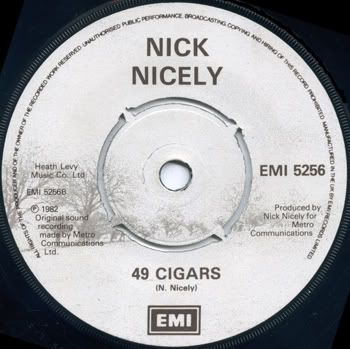
Incidentally this track was one of the influences behind my recording of 'Indigo Girl & The Blue Eyed Boy' - I'll admit that's a somewhat flattering lineage to give my song - The Pink Floyd, The Beatles, Nick Nicely - but what the heck !!!!
More info on Nick can be found here:
Nick Nicely unofficial webpage
'49 Cigars' can be heard on Nick's Myspace page here:
Nick Nicely
Imagine Syd Barrett era The Pink Floyd covering 'Strawberry Fields Forever' and you'll be getting close to the sound of this record.
Long time followers of my blogs elsewhere will know that I have a penchant for all things psychedelic and '49 Cigars' delivers in spades.

Incidentally this track was one of the influences behind my recording of 'Indigo Girl & The Blue Eyed Boy' - I'll admit that's a somewhat flattering lineage to give my song - The Pink Floyd, The Beatles, Nick Nicely - but what the heck !!!!
More info on Nick can be found here:
Labels:
49 cigars,
Hilly Fields 1892,
Nick Nicely,
Pink Floyd,
Steve Kelly,
Syd Barrett,
The Beatles
Favourite 'b' sides - Candy And A Currant Bun
This 'B' side of The Pink Floyd's 'Arnold Layne' is one of THE great Syd Barrett recordings.
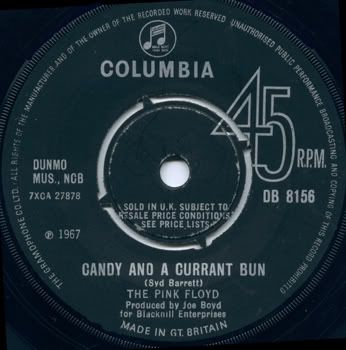
It throbs and pulsates and goes into overdrive during the middle section - ought to have been a single in its own right. Hear it below.
 Front cover to Arnold Layne.
Front cover to Arnold Layne.

A period Floyd poster.

It throbs and pulsates and goes into overdrive during the middle section - ought to have been a single in its own right. Hear it below.
 Front cover to Arnold Layne.
Front cover to Arnold Layne.
A period Floyd poster.
Labels:
Arnold Layne,
Joe Boyd,
Pink Floyd,
psychedelia,
Syd Barrett
Favourite 'b' sides - Earth Angel
Somewhat amazingly this killer doo-wop classic was originally released in September 1954 (the month after yours truely was born) as the flip side of Hey Senorita.
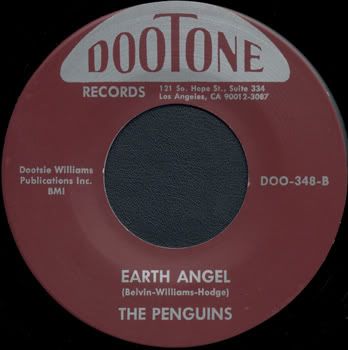
However it was Earth Angel that received all the air play and has since sold millions of copies worldwide.
If you don't know this track you may go outside and shoot yourself now !!!!!!
Alternatively you can go and hear it here:
http://www.myspace.com/theepenguins

However it was Earth Angel that received all the air play and has since sold millions of copies worldwide.
If you don't know this track you may go outside and shoot yourself now !!!!!!
Alternatively you can go and hear it here:
http://www.myspace.com/theepenguins
Labels:
1954,
Earth Angel,
Hey Senorita,
Steve Kelly,
The Penguins
Picking Bones video
My good friend Dylan Henderson has produced a film to go with my instrumental Picking Bones - here's the result:
See other videos by Dylan Henderson:
Dylan Henderson
Dylan's Myspace page:
Dylan Henderson on Myspace
See other videos by Dylan Henderson:
Dylan Henderson
Dylan's Myspace page:
Dylan Henderson on Myspace
Labels:
Dylan Henderson,
Endless Records,
Picking Bones,
Steve Kelly,
Tipping Point,
Wales
Sprigs Of Heather video
Like secret footage smuggled out from behind enemy lines - this film marries a private performance with a 'work in progress' recording. Tantalising glimpses of a song's evolution.
Obituary - Les Paul
Guitarist and inventor with huge influence on pop and jazz
By Tony Russell - Published by The Guardian Thursday 13th August 2009
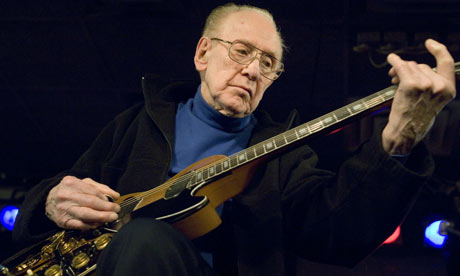
Guitar legend Les Paul performing at 91 at the Iridium Jazz Club in New York in 2007. Photograph: Colin Archer/AP
In that setting, the records of Les Paul, who has died aged 94, and his partner Mary Ford were simultaneously throwbacks to an earlier Tin Pan Alley and wittily modern. On paper, they were a competent nightclub singer and a technically superb session guitarist, reviving such faded blooms of the music publishers' back catalogue as Nola, Tiger Rag and The World Is Waiting for the Sunrise. On disc, they were legion: Ford, multitracked, became a vocal group, while Paul, not only multitracked but at several different speeds, turned into an orchestra of guitars, some twanging in the recognisable accents of country or, others skittering octaves above like harmonised bats, all to a beat of rigorous simplicity.
Born in Waukesha, Wisconsin, Paul was always fascinated by sounds and their preservation. At the age of nine, he is said to have set himself the puzzle: "Why does my window rattle when the train goes by?" Soon afterwards he built a home recording machine out of gramophone and car parts. As a teenage guitar and banjo prodigy, he was billed as Red Hot Red, the Wizard of Waukesha, and joined a western band on Chicago's powerful radio station WLS.
By the mid-1930s he had the reputation of a versatile studio musician, working without strain not only in hillbilly settings but alongside jazz artists including Louis Armstrong. Among his early recordings were accompaniments to the blues singer and pianist Georgia White. He tentatively opened his own recording career in 1936 with four country songs for the Montgomery Ward mail-order store's budget label, under the sobriquet Rhubarb Red.
Later in the decade his jazz-flavoured trio – partly modelled on the ensembles of Django Reinhardt, whom he greatly admired – became nationally known on bandleader Fred Waring's radio show. He also participated in one of the earliest NBC telecasts. For most of the 40s, he was based in Hollywood, accompanying artists such as Bing Crosby and the Andrews Sisters on radio and records. In 1944, he joined the roster of Jazz at the Philharmonic for a concert.
During this period, he developed "the log", a solid-body electric guitar made from a piece of maple. He also conceived, with the help of the new reel-to-reel tape recorder, the trick effects of "sound-on-sound" (overdubbing), slapback echo and speed-changing, which he would deploy in his duets with Ford, who joined him in 1947, recommended by Gene Autry. They married in 1949 and the following year moved to New York to begin a television series, Les Paul and Mary Ford at Home, on which they launched their records.
Among their many hits were Mockingbird Hill and the chart-topping How High the Moon and Vaya Con Dios. In their book What Was The First Rock'n'Roll Record?, Jim Dawson and Steve Propes ascribe to How High the Moon "the first distinct 'rock'n'roll' guitar solo... Nearly every solo by Danny Cedrone of Bill Haley and His Comets refers to it. Cedrone's striking work on Rock Around the Clock is almost an echo of the Les Paul style."
"I've never let anybody know exactly what kind of pick-ups or how I get my sound on records or onstage," Paul once said. "That big, fat, round, ballsy sound with the bright high end is the Les Paul sound – nobody else has it."
The Paul-Ford formula waned after the arrival of full-blown rock'n'roll, and they divorced in 1964; Ford died in 1977. Paul continued to innovate in guitar and recording technology, and is credited with inventing the eight-track tape recorder. The Les Paul guitar, manufactured by the Gibson guitar company, came to be highly regarded by rock guitarists.
In the mid-70s Paul re-emerged as a performer to play concerts with the country guitar virtuoso Chet Atkins, whose older brother Jimmy had played rhythm guitar in Paul's trio 40 years before. Their 1977 album Chester and Lester won a Grammy.
In 1980, Paul underwent heart surgery but recovered to resume playing, and had regular engagements at two New York jazz clubs, Fat Tuesday's and the Iridium. He won a second Grammy in 2006 for the LP Les Paul & Friends: American Made World Played.
No conservative about guitar players – he was an early admirer of Jimi Hendrix – he would occasionally appear on stage with rock stars such as Jeff Beck. In 2008, when he received an American Music Masters award from the Rock and Roll Hall of Fame, the concert was attended by admirers including Duane Eddy, James Burton and Slash. His remarkable career has been surveyed in two documentaries, The Wizard of Waukesha (1980) and Chasing Sound: Les Paul at 90 (2007).
By his first wife, Virginia Webb, he had two sons, and the couple divorced. By Mary, he had a son and a daughter. His four children survive him, as does his companion, Arlene Palmer.
Les Paul (Lester William Polsfuss), guitarist and inventor, born 9 June 1915; died 13th August 2009
guardian.co.uk © Guardian News and Media Limited 2009
Subscribe to:
Posts (Atom)


